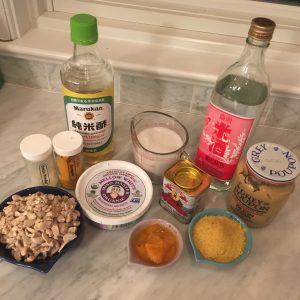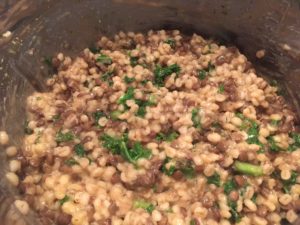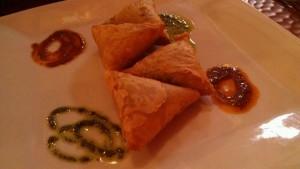Tag Archives: strict-vegetarian
Vegan Pressure Cooking – New and Expanded
By JL Fields
Fair Winds Press 2018 $22.99
With all the discussions about the benefits of pressure cookers for preparing beans and grains, I was excited to read and cook from Vegan Pressure Cooking – especially since the revised, expanded edition includes special instructions for Instant Pots!
There are some helpful, basic tips on pressure cooking in general, adjustments for various types, and plethora of full-page, color photos of the finished dishes – for roughly half of all recipes. There’s a serious emphasis on beans and grains – which is where pressure cookers really shine. Sometimes, for green and other non-starchy vegetables, the set-up, pressure-raising and releasing takes longer than simply plopping a pot on the stove (or using the microwave).
I am an Instant Pot fan, but its size encourages tucking it away in the pantry. Out of sight; out of mind. I was counting on this book re-energizing that appliance. And it certainly did. As a result, the IP is still on the counter after a positive week of trying some of JL Fields’ recipes. I skipped the green beans as not logical for an IP and headed toward the beans and grains.
The first recipe was “Lentil, Kale and Barley Risotto.” Two cups of cooked lentils were defrosting in the fridge and kale and jalapenos were in the hydrator – so it was a perfect choice. The recipe worked exactly as described and was delicious – but three of us ate most of it (and the servings listed are 6-8). Next time, I would be less judicious with the jalapeno (the heat was barely detectable) and add the baked tofu as the author suggested (or perhaps a sliced vegan sausage or two) which might stretch it to the suggested servings. The photo was a very tight close-up so it was hard to tell if my effort looked like the author’s.
“Chickpea Hummus” was next. Homemade hummus is a staple in our house – but more often than not from cans. A quick, delicious version from dried beans would be welcome. The chickpeas were soaked for 24 hours and then sat, drained, in the fridge for a day. I subbed the white part of leeks for the onion (that’s what I had) and reduced the garlic by half (since aggressive garlic is not loved by all in this house). There were two problems – the 15 minutes under high pressure with natural release was not nearly long enough in an IP (I let it gurgle on saute for another 20 minutes). And the flavor was bland – particularly surprising because onion is not traditional. Perhaps adding cumin, or maybe more lemon. Next time, I will try high pressure for 20-25 minutes (after all, preserving the shape of the chickpea is not relevant for hummus), use a real onion and up the garlic a little to the suggested quantity (and add cumin).
The next choice was “Lemon Green Bean Risotto.” Except for the color of the dish, this was a success. Perhaps the stock was too dark giving the final product an unappealing brownish tinge. Other than that, it was creamy and hands-free – pretty amazing for risotto. I will definitely try this again with a lighter colored stock.
The Wicked Healthy Cookbook – Free. From. Animals. (Preliminary Review)
By Chad Sarno, Derek Sarno, and David Joachim
Grand Central Life & Style, Hachette Book Group, New York, NY 2018 $30
I love this book!!! From the minute it arrived, I was lost. Just skimming the essays, lists, Pro Tips and stunning recipes and images took me into the wee hours. Putting it down was not an option. Granted, my guilty pleasure is reading cookbooks. But this is a very special tome. Just when it felt like plant-based cuisine had reached its limits, with book after book adding a few new spins but churning the same ground, Wicked Healthy has seriously upped the ante. It’s fun, exciting, innovative, energetic, – the enthusiasm for the possibilities of plant-based gastronomy leaps off the pages. Dust off that mandoline!
To be clear this is not a book for every veg-forward cook. It is not an intro to the philosophy or a beginners’ guide. Some of the recipes are challenging, time-consuming and utilize esoteric ingredients that may require the resources of Whole Foods, Amazon, H-Mart, Thrive, a sophisticated farmers market and a few small mail-order houses – and even then you may have to be satisfied with recommended subs. It’s also, not surprisingly, a bit cheffy – many ingredients lists include other recipes so, unless you have a staff, there is sometimes serious time required. But it will be well-spent, satisfying time – even the process of discovering new or less-available ingredients will be well-spent, satisfying time. Bottom line, if all you do is just read The Wicked Healthy Cookbook, you can’t help but appreciate the expanded possibilities of plant-based cookery.
This is just my first review. I am going to cook my way through a good chunk of the book and post the results as I go. Starting with their bold new take on mushrooms: King Oysters, Maitakes, and Lobsters. What fun!! I can’t wait.
(One question – olive oil instead of avocado oil for high heat cooking?)
Alternative Vegan – Healthy Plant-Based Recipes that Break the Rules
By Marie Reginato
Page Street Publishing, Salem, MA. 2017
I love the sentiments and attitude in this book! After more than a decade on a relatively strict “whole food, plant-based” diet, we started a little rethinking – prompted by a series of research reports that stacked one question atop another. I worried about the quantity and quality of our omega-3 and protein intake. We were also feeling a little bored and needed to amp up the deliciousness of our food. We agreed it was time to break just a few of the rules: we added some pastured organic eggs, a little sustainable, low-mercury, high-omega 3 seafood and two specific European cheeses to our diet*.
A couple months later “Alternative Vegan” landed in my lap – encouraging the breaking of pretty much the same rules!
Aside from the affirmation provided by the author (saying just what we wanted to hear), this is a solid effort that adds variety and originality to the cookbook shelf – clear recipes that work, full-page, bleed images of every recipe that inspire, and a thoughtful approach to food in general. Wherever there is rule-breaking, the author provides a vegan alternative.
The recipes tend to depart from the expected which is, for those of us with dozens of plant-based cookbooks, a welcome relief. On the other hand, these are not “throw dinner together in a few minutes” recipes. Not even the 30-minute ones. The ingredient lists tend to be lengthy but not esoteric – if you’ve been eating plant-based for a while, you’ll find most of them on the pantry shelf. Cupboard Curry is just that and Minty-Pistachio Falafels with Tzatziki gives these old stand-bys a fresh flavor profile. Also welcome are two takes on sliced “pre-cooked polenta rolls” that get a yummy dish on the table quickly.
As a lover of dinner leftovers for breakfast, I found the Morning Glory Bowl even better; it’s a made-from-scratch, well-seasoned, Swiss chard, spinach, fennel, avocado and dill breakfast (or maybe brunch) dish. The recipes bounce between creative riffs on traditional favorites and some really unique ideas – and that originality extends to the unexpected chapter titles. There’s Breakfast and Dessert (Dark Chocolate with Lime Zest & Pumpkin Seeds!!) – but standard headings stop there. The chapter on Bento Boxes and Buddha Bowls adds some new perspectives as does the Ex-Rated chapter on pizza and pasta. But the main events are mostly in Eating on the Vedge.
I do take issue with some of the “alternative” choices – IMO, eggs should be “pastured” as well as organic and the seafood choices should align with the Environmental Working Group’s detailed assessment of sustainable, low-mercury and high omega-3s. But those are my personal choices and all of the seafood recipes will work just fine with other species …..
*The specifics of our alternative choices are covered in the post – “Shhh! We’ve Decided to Break a Few Rules!”
My Take on “Veganism”
Up until a dozen years ago, we’d been innocently and happily eating a whole-foods, sugar-free, “healthy diet” for about three decades; it included low-fat dairy, white meat chicken and fish. But then, my husband “pushed through” on a New York Marathon feeder race, collapsed and was unceremoniously hauled off to a local hospital. That was when we learned that he had plaque on his arteries! I took this as a personal affront to my hard-won nutritional knowledge and culinary expertise.
After listening to my angst-ridden breast-beating, a friend handed me the “Eating” DVD (3rd Revision) – it was a revelation. The interviewees weren’t McDonald addicts or slab-of-beef on the plate types; these were people who’d been eating just like us. And their health profiles were just like ours. Once they embraced a whole-foods, plant-based lifestyle – aka veganism – their health improved: plaque disappeared from arteries, insulin requirements nose-dived, weight slid off…… We were smitten and embraced this new life-style with vigor and enthusiasm.
Today we’re still eating a primarily plant-based diet. We know that we’re healthier with it, that animals suffer less because of it and that the planet is better off (we could trade our Prius for a Humvee and our carbon footprint would still be impressive). But we’ve lost the religiosity. We prefer the term WFPB over Vegan because it is not so loaded. We still use the terms vegan or strict vegetarian in restaurants because plant-based does not compute with servers. But to the rest of the world, we call it a whole-foods, plant-based diet.
Over time, we’ve gotten easier with it. When we travel or dine out – especially at friends’ homes – we expand our options to include wild-caught salmon, mussels, oysters, brook trout and a couple other low-mercury, high omega-three, sustainable species (kudos to the Environmental Working Groups for simplifying this). Blue crab and lobster also make the few-times-a-year list because there are Crab Feast and Lobster Bake traditions on both sides of our families. On occasion, we also eat free-range “humanely raised” eggs. It makes life easier for everyone and, frankly, we welcome these occasional additional options. That said, when we are home, we eat a pretty strict WFPB diet – we like it; it’s easy and it allows us to “regroup” especially after long bouts of travel. When we entertain, it’s almost always a WFPB meal as well; we work hard at delivering luxuriously delicious meals that usually end with a dark chocolate dessert – and, hopefully, make the lack of animal products unnoticeable and irrelevant.
We don’t proselytize and only discuss our food choices when asked; we hope that this low-key approach might make the plant-based concept less off-putting and more appealing. It seems to us that the fewer animal products one eats and the more organic produce one consumes, the better off everyone is (for organic, we shop with the EWG’s Dirty Dozen [actually 20] and Clean Fifteen lists). As Columbia Professor Emeritus Joan Dye Gussow would say to the “Earth Friends” fourth graders: “it’s better for both worlds you inhabit – your body and your planet.”
We are fans of Meatless Mondays, Mark Bittman’s “VB6” (Vegan Before 6 pm), and any other variation that encourages people to dip a toe into this lifestyle. This is not a religion; it is a choice that is a win-win-win for you, for the animals, for the planet. Our philosophy is: just do what works for you; no one is taking notes.
VEGANIZE IT! Easy DIY Recipes for a Plant-Based Kitchen
BY Robin Robertson – Houghton Mifflin Harcourt March 7, 2017. $25. Amazon $14.92/ Kindle $12.99
Another really good book from one of the top vegan cookbook authors. Robin Robertson’s books are classics and I have most of them. So I had high expectations for this one. It’s a beautifully designed book with a stiff fold-in cover for marking your place and lots of full-page photos and chapter intros that sometimes bleed across a double-page spread.
The chapters are similar to those of an omnivore cook book – with a twist. Plant-Based Meats, Vegan Charcuterie, Instead of Seafood, Dairy-Free and Egg-Free, Too…. all very enticing.
Since 2010, I’ve been turning to Steen & Newman’s “The Complete Guide to Vegan Food Substitutions: Veganize It! Foolproof Methods for Transforming Any Dish into A Delicious New Vegan Favorite.” And collecting recipes from chef-written cookbooks, blogs and the www. There have been so many advances in plant-based cooking in the past six years that I thought Roberstson might, essentially, be providing an updated, cutting edge version of “The Complete Guide…”. And in some ways she has. But I was hoping for some break-through ideas instead of riffs on existing chef or blogger-developed veggie cuisine. Or at least a compilation of those best of the best ideas. But I misunderstood the intention – which might have had something to do with the similarity of the titles…..
Instead, the book provides “clean” vegan recipes for lots of basics like sour cream cream cheese, cheesy sauces, ricotta, hollandaise, feta, butter!, gravy plus many, many more. Beyond basics are burgers, pulled pork, fish ‘n chips, sausages, meatballs, sea scallops, five bacon recipes, and more. Many of these products are available in the supermarket freezer or refrigerator case but made with a laundry list of additives and other unpronounceable ingredients. So this is why I add the word “clean.” Ms. Robertson first chapter includes home-made versions of pantry items (many of which are not vegan in their store-bought versions). Each chapter also includes more involved recipes that use a few of the basics made from the included recipes or, if time is short, from store-bought versions.
I started my review by preparing a couple of the recipes. First was Creamy Ranch Dressing that starts with 1 cup of mayo – it had good flavor but the mayonnaise was too prominent so I cut it with a little almond milk that also made it more pourable. The second one was Cheddary Sauce which is pictured below (these are my photos, not from the book). This was a tasty cream sauce and it worked well over a steamed veggie and quinoa bowl, but it didn’t taste anything like cheese, especially cheddar, which the name implied. I made it in a Vita Mix so just letting it blend a little longer heated it up – once the cashews had been soaked, it was quick and easy despite a lengthy list of ingredients. I will make it again – perhaps amping up the seasonings and playing with the liquor choices. Next up are the five bacon recipes and the pulled pork.



A couple nitpiks: Recipes labeled with cheesy names have to taste cheesy – nooch just doesn’t taste cheesy to me. And there isn’t any nutritional info – I’d like to know the calorie count and the percentage from fat – is it a 30-cal tablespoon or a 125 cal one? Also while the cashew craze has been well addressed, alternatives would be appreciated (since cashews are high-FODMAP) and a little more on aquafaba would also be helpful and suggestions for those among us who choose oil-free.
Bottom line – this book is a keeper. There are enough interesting concepts in here to encourage experimentation. It is not haute cuisine, but it is reliable, tasty, clean vegan. And that’s worth a lot.
Mala at Wailea Marriott – unexpected plant-based meal in a spectacular setting
Searching out plant-based, vegan options in Maui proved a positive and fun adventure. The biggest surprise, not listed anywhere, was the restaurant at our hotel. What a surprise! Mala has a separate Gluten-Free & Vegan Menu. Chef Mark Ellman and his business partner Shep Gordon teamed up with Top Chef Finalist Chef Sheldon Simeon (and one of Food & Wine 2014 Best New chefs) to create delicious, organic and locally sourced dishes that are an eclectic blend of Mediterranean and Hawaiian flavor profiles.
The setting is simply gorgeous. The upper level airy dining room features a clean, contemporary, teak-accented look with long, unobstructed water views. If weather permits, dine on the lanai.
On the Gluten-Free and Vegan Menu , there are four vegan starters, one salad, and a disappointing single entree. But we found that the server and chef were happy to work with us to create a second plant-based entree since we always share and prefer to taste a variety of offerings. We combined one of the starters with a few of the five vegan sides. Island Vegetables featured well seasoned cauliflower, mushrooms, carrots and baby bok choy on a bed of coconut peanut sauce ($28). We also sampled the fried local pickels ($7) and the Fried Tofu ($12).
Eating Plant-Based in the British Virgin Islands
Provisioning for a whole foods, plant-based diet is pretty easy in the BVI if you are on a charter yacht or staying in a villa. On Tortola, recently renovated Rite-Way about a quarter mile from the Moorings Charter Yacht Base (the largest in the world) has a good assortment of grains, beans, produce, some frozen veg entrees, soy milks and Bobby’s even has local tofu. You can buy home-made hummus at the Patisserie on the Moorings entrance road – and until recently they had a fab tofu salad (we keep asking when it’s coming back). There are tubs filled with a variety of pickles (delicious cornichons) and lots of olives. Even the little market in Leverick Bay Resort & Marina on Virgin Gorda – on the southern edge of North Sound – has frozen vegan entrees.
But if you wish to dine out, and have the full BVI experience, then things get a bit more challenging. Vegetarian is, of course, easier because chefs sub cheese for meat. It seems the higher end restaurants are beginning to recognize the sea change (and, of course, the Rasta eateries and stands are always ready with a quick meal). But we have ferreted out a few places that offer a lovely ambiance, spectacular views and offer at least one whole food, plant-based app and one entree right on the menu.
Saba Rock Resort in North Sound is accessible by their ferry from Leverick Bay or Bitter End Yacht Club or by dinghy from your boat moored right off this one-acre bit of paradise. Rooms are simple and immaculate and the menu offers several vegan entrees: For lunch at The Pub, try three black bean crispy tacos ($16.95) , Black Bean Veggie Burger ($14.95) or a vegetarian traditional West Indian Curried Roti. Everyday from 4-6pm, it’s Happy Hour with $2.50 Painkillers, Rum Punch & Carib Beer. For dinner, there’s an all-you-can-eat buffet that features a fresh salad bar and a wide range of hot entrees ($29.95) check to see if they’re vegan offerings that night. Among the a la cart entrees is a dinner size West Indian vegetarian Roti ($29.95) or Cuban-style Fire-Roasted Vegetarian Kebobs ($27.95) featuring mini black bean cakes – accompanied by the salad bar. Tables are literally right on, actually over, the water – so it’s easy to watch the large schools of Tarpon circling the underwater lights or look across the bay filled with yachts on moorings. Contact – (284) 495-9966 or VHF Ch. 16.
Just across the Sound, the famous Bitter End Yacht Club resort is not so accommodating – and that was a bit of a shock. There are four eateries. We ended up with Conch Fritters on the premise that there is so little conch in conch fritters that it was irrelevant – and we needed something to sop up the wine and beer. They might have been able to rustle up a simple salad or a steamed/grilled veggie plate or white pasta with red sauce had we asked, but there is nothing on their menu that works (even modified) and we just weren’t up for another heavily oiled, uninspired veggie plate or pricey but lackluster pasta with tomato sauce from the kids menu – no matter how gorgeous the view. But if you are looking for fresh bread and other bakery items for the galley – head to Winston’s.
Around the corner, Leverick Bay offers three dining options. Chef George’s upper level fine dining room offers a tomato and mozzarella salad ($15) or Bruschetta ($11) that can be made without the cheese. For an entree, there’s a Creamy risotto, beurre blanc, seasonal vegetables and aged balsamic topped with crispy carrots (leave out the cheese and/or buerre blanc). The Cove and Bar offer more veg friendly options: Garden Salad ($12) or Hummus and pita chips ($12) to start followed by a Veg Pizza (skip the cheese $19). Entertainment is excellent. Michael Bean’s pirate bit Mon-Wed 5-7 pm is always well-attended and a family fave. We spent a week in their mooring field and never tired of his bits). Friday night’s the Beach BBQ (we found lots to eat on their vegetable forward buffet) that features the must-see Moko Jumbie Dancers and Thursday nights it’s the Salt and Pepper Shakers.
Around the corner, at Biras Creek Resort, we really loved the Fat Virgin’s Cafe overlooking the dinghy dock. Brightly colored picnic tables were awash in local specialties – so we always found something delicious to eat. Sadly, Biras Creek closed – we don’t know for how long or what happened to the cafe – so call.
Overlooking Manchioneel Bay, private, secluded laid-back Cooper Island Beach Club (accessible via their private ferry from Road Town or dinghy in from the mooring field) has been one of our all-time family favorites – and it just keeps getting better and better. But it’s been sooo discovered that getting a mooring requires a first-light run. The chef offers a Roasted Garlic Hummus Wrap with artichoke hearts and Cajun fries ($11) on their lunch menu. Unfortunately their Traditional West Indian Roti, which our son rates very highly, is made with chicken (maybe they will offer a veg alternative soon). For dinner they offer hummus as a starter and Penne with sauteed vegetables and a pesto-tomato Sauce ($20) as an entree. Another possibility, Eggplant Rolls filled with goat cheese and red peppers ($19), might be doable without the cheese. We understand that they will also accommodate gluten-free, so this seems a very real option. Happy Hour is 4-6pm with two for one drinks. Rooms are available at the Beach Club or around the island at Cooper Island Villas.
Vegetable Rotis, like the ones served at Saba Rock, are an authentic taste of the Caribbean that originated in Trinidad. It’s a a large flatbread filled with curried meat, fish or vegetable – kind of like a huge burrito. We are always on the look-out for the vegetable versions, not too hard to find, and one of the very best is served at the little Roti Palace, tucked behind Samarkand Jewelers on Old Main Street, Road Town Tortola ($10-25 for lobster). There’s a little dining area and an outdoor patio – or take-out. (They’re hand-made so be prepared to wait a bit.) If you want to be 100% sure there is no chicken or fish stock in your roti, look for a Rastafarian restaurant that serves I-tal food – which is strict vegetarian.
Pirates Bight Restaurant on Norman Island re-opened in December 2012 with a beautiful, brand new, larger facility. The dinner menu features a “Vegetarian’s Delight” ($28) that changes daily – hopefully their delicious West Indian Vegetable Roti filled with traditional curried spiced vegetables will be on the rotation. There’s also a trio of veggie salads: Greek Bounty salad – sliced tomatoes, cucumbers, feta cheese, olives, with fresh pita and home made hummus ($16), Garden ($13 ) and Fruit platter ($12). It appears that lunch is no longer served (there used to be a vegan roti, veggie burger topped with grilled pineapple, fresh tomato, lettuce and onions, and grilled veg panini). Thursday through Sunday, the music starts at 8 pm (and Wednesday is Karaoke). Happy Hour is 4-6 pm; the bar menu offers chips and salsa ($10), sweet potatoes and tania chips ($10), french fries ($10) and onion rings ($10).
Also in The Bight, just off Norman Island, the infamous floating “Willy T” (aka The William Thornton) serves Lunch (12-3 pm) and Dinner (6:30-9 pm) and offers a Veggie Burger ($9), along with fries/rice and coleslaw. They’ll also rustle up a simple romaine salad since it is the base for their meat and fish salads. Diving off the top deck (clothed or not) is a long-time tradition.
At Tortola’s West End in Sopher’s Hole, The Jolly Roger has been totally reinvented as the open-air Fish ‘n Lime Inn & Restaurant . For lunch Heather’s Mandarin & Cashew Salad, hold the feta ($16) and/or Hot Spinach and Avocado Cheesecake ($15) and for dinner Risotto Balls ($15) and Heather’s salad – no vegetarian entree option.
Other possibilities include: Mellow Moods Cafe, an Ital eatery at the Road Town round-about, Chic Gourmet at Fish Bay, Nature’s Way in Mill Mall also in Road Town (run by Seventh Day Adventists), gorgeous top of the pack Sugar Mill offers rotating vegetarian selections at lunch and dinner (min $35/pp count on $60/pp at dinner) and also offers Gluten free and two-for-one drinks as you watch the sunset.
What did we miss?
Maui – On the Road to Hana
We decided to drive the supposedly totally off-the-beaten-track but spectacular Road to Hana along Maui’s northeast coast. The warnings were universal – take lots of water and food, gas up the car – there’s nothing along the whole route – perhaps 55+/-miles with 58 bridges (many one-lane wide) and over 250 serious curves – plus untold vistas and one-car-wide pull-offs. So the estimate is about 4 hours to get to Hana and as long to get back – with stops at the top five attractions. The warnings also advised against taking the “dotted line” road back to Wailea that would complete the circuit – so we had to come back the same way or void our car rental agreement if we were found out…
Consequently, we wasted a good hour getting prepared for this major odyssey in our little fire-engine red convertible – about half the rentals in Maui are convertibles and most of them were headed to Hana at the same time we were. Many of the warnings proved over the top or just plain wrong. Except one – there are 58 bridges, most one-lane wide – and over 250 curves – so no wine and beer on this trip. But were were happy that we had provisioned at Down to Earth – an organic, all natural market just south of the Hana Road that makes delicious plant-based sandwiches ($7.99 each) – subs and wraps – and offers a wide range of “healthy” chips, drinks and well-priced water. downtoearth.org.
The drive was made far more interesting because we rented a GyPSy GPS program that provided fascinating commentary on what we were passing or stopped at – along with a lot of history and anecdotes during the long stretches of gorgeous scenery.
Our experience was that there are services along the way – but maybe not year round – so check. There’s a small cluster of shops and snack bars, tiny family-run roadside stands – some offering fruit, vegs, burgers or pastries. And there is a gas station in Hana along with some basic dining options, an “historic General Store” that has seen better days, and a resort. FYI: several people told us later that the “dotted line road,” which would have made this an even more interesting drive, is just fine at this time of year and we should have taken it.
For images of the Road to Hana, please see this link to Pinterest.
Artichoke – Vegan options at this casual eatery near the NYC HighLine
Artichoke Basille’s Pizza West (212-792-9200) at 114 Tenth Avenue at 17th Street in the Meatpacking District is ideally located just steps from an entrance to NYC’s HighLine park. The casual, tavern atmosphere of dark wood, marble tables, a comfortable booths with a long zinc bar.
For those of us on a vegan/plant-based diet, there are a couple superb choices. The super large signature Artichoke is stuffed with breadcrumbs, parsley & pignoli nuts ($15) swimming in a yummy broth and the family-sized Boxed Salad features a spring mix with artichoke hearts, red onion, olives, tomatoes, mozzarella & house dressing ($15 ) – just ask for the cheese on the side. And if you want more, Basille’s home made Garlic Bread Sticks with dipping sauce ($11) also works for dipping into the artichoke broth.
For your cheese-eating friends, the enormous 18-inch pizza is pretty amazing- packed with an array of unique mixes of ingredients – crab, artichoke, burnt anchovy, white pie ($28-30). Try the “wedge” ($15) that’s a third of that huge pizza (hoping that maybe they’ll consider a soy cheese pizza?).
And – good news – there’s an Artichoke Light in the Delta Airlines terminal at LaGuradia. Great for those of us who are Delta regulars.
Zitoune Moroccan Cuisine, Mamaroneck, NY – A host of Vegan Choices plus a Belly Dancer
Along a busy stretch of Boston Post Road – 1127 W. Boston Post Rd., Mamaroneck, NY 10543 (914-835-8350) – this charming, inviting small eatery belies its surroundings. The extensive menu of classic Moroccan dishes nets a very good selection of plant-based/vegan dishes.
On the App menu, we particularly enjoyed the Vegetable Cigars – Rolled, crisp Filo surrounds marinated Vegetables (Carrot, Zucchini, Red and Green Pepper) $6, a Lentil Tagine –
Lentils cooked in a traditional Tagine Pot with Onions and Tomatoes $7.50
Three soups – Chourba $6, Lentil, $7 and Harira $7.50 are all vegan. As were three of the salads – Zitoune $6, Mediterranean $7 (with no feta) and Mediterranean Orzo $7. Always ask about cheese – they sometime leave it off the menu description.
Among the Dinner entrees we found several enticing choices –
Berber Couscous $15.50 – Traditional Moroccan Couscous as it’s enjoyed in Marrakech, served with Seven Vegetables and an Aromatic Broth
Vegetable Tagine $9 – Saffron Vegetable broth, with Carrot, Potato, Pepper and String Beans served in a traditional Moroccan Tagine
Moroccan Stewed White Beans $9.50 – with Tomato, Olive Oil, and Moroccan Seasoning, garnished with Butternut Squash
Couscous el Fassi $16.50- Fez style with Caramelized Onions, Raisins and Chick Peas
There’s also a can’t be beat Early Bird Special 5-7pm for $15.95. An appetizer, entree with a glass of wine and coffee or tea. it’s likely that one of the choices will be plant-based – but no guarantee.
Lunch is served Monday to Saturday and brunch on Sunday. The all-vegan soups are only $4, the salad choices are more extensive ($5-8) and the entrees range from a Veggie Lovers Sandwich ($6) to a Vegetable Melange ($8), the Lentil Tangine ($7.50), and the Vegetable Berber Couscous ($9).
There’s also a Prix Fixe special at lunch (11:30-1:30) $11. A soup or salad plus an entree and coffee or tea.






























